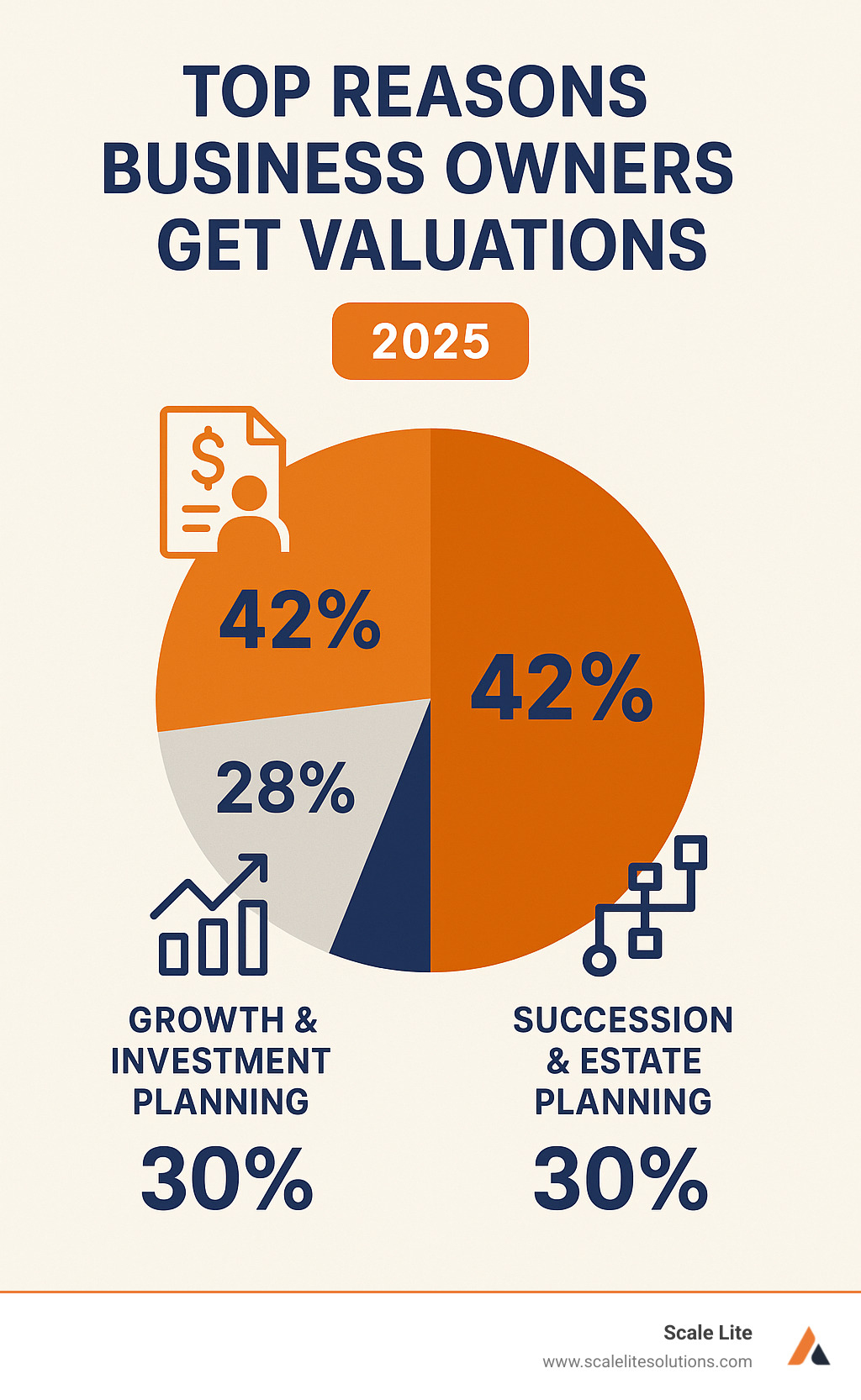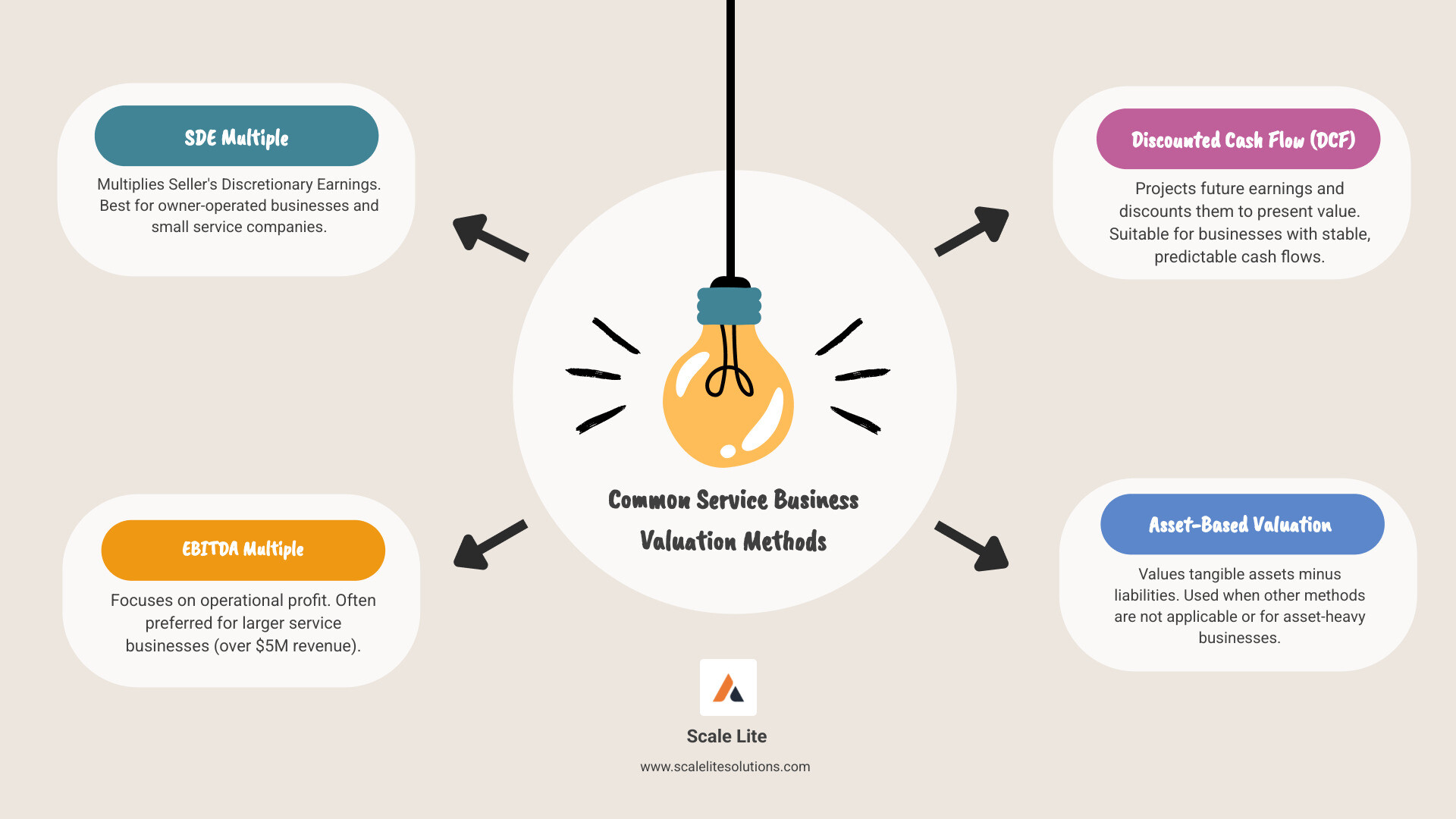
How to Value Your Service Business Without Losing Sleep

Why Understanding Your Service Business Value Matters
Understanding how to value service business operations is about more than a price tag; it's about knowing the true worth of your life's work to make informed decisions about your future.
Quick Answer: The 5 Main Ways to Value Your Service Business
- SDE Method - Multiply your Seller's Discretionary Earnings by 2-3x (ideal for owner-operated businesses).
- EBITDA Multiple - Use earnings before interest, taxes, depreciation, and amortization times an industry multiple.
- Asset-Based - Calculate total assets minus liabilities (best for asset-heavy businesses).
- Market Comparables - Compare to similar businesses that recently sold.
- Discounted Cash Flow - Project future earnings and discount them to present value.
Knowing your business's value is critical, whether you're planning to sell, bring on a partner, or simply measure your progress. As Shabir Ladha, CPA, a Chartered Professional Accountant and business advisor, puts it: "Not knowing your business's worth is like taking your biggest asset and saying 'let’s just sell it off and see what we get!'"
The reality is stark: According to research from Jobber, 70% of business owners over 60 don't have a succession plan. Many find their business is worth far less than expected when they finally decide to sell.
But here's the good news: service businesses have hidden value. Your customer relationships, brand reputation, and operational systems can be worth more than your physical assets combined. Most small service businesses sell for 2 to 3 times their annual discretionary earnings. A business generating $200,000 in owner earnings could be worth $400,000 to $600,000—but only if it's structured properly.
I'm Keaton Kay, founder of Scale Lite. I've spent years in private equity evaluating and growing service businesses, giving me unique insight into how to value service business from both owner and buyer perspectives.

Why Your Business's Worth is More Than Just a Number
A business valuation is like a GPS for your entrepreneurial journey; you need to know where you are before you can figure out where you're going. It's a practical tool for major business decisions.
Common reasons for a valuation include:
- Selling a business: A professional valuation gives you the confidence to negotiate from a position of strength. Understanding How to Sell Service Business starts with knowing its worth.
- Attracting investors: Solid numbers back up your growth potential and show investors you understand your business's value.
- Exit and succession planning: Your business is likely your largest asset. A valuation is essential for a robust Business Exit Plan and a smooth transition, whether to family or a management team. Learn more about the Exit Plan Definition.
- Partnership agreements and legal matters: Valuations ensure fairness when bringing on partners, adjusting ownership, or for tax planning and divorce settlements.
We recommend an annual valuation. Your business changes every year, and an outdated valuation is like using last year's map to steer this year's terrain.
Understanding Fair Market Value vs. Book Value
Many owners confuse book value and fair market value, but they're often worlds apart.
- Book Value: This is what's on your balance sheet (Assets - Liabilities). It's based on the original cost of assets minus depreciation. A truck bought for $30,000 might be on the books for $20,000, even if it costs $35,000 to replace today.
- Fair Market Value: This is the price a willing buyer would pay a willing seller, with neither under pressure. It considers market conditions and, crucially, intangible assets.
For service businesses, most of your value is in these intangibles—your team's expertise, customer relationships, and reputation. These don't appear on a balance sheet but are what buyers truly value.
The Critical Role of Intangible Assets
Intangible assets are the invisible drivers that can determine whether your business sells for two times earnings or five times earnings. Key intangibles include:
- Brand Reputation: A strong brand allows you to charge premium prices and attract customers and talent effortlessly.
- Customer Relationships: A loyal customer base means recurring revenue, which is what buyers pay a premium for.
- Proprietary Processes & IP: Your unique way of doing things—whether it's a training program or a diagnostic process—creates a competitive advantage. Well-documented processes also prove the business can run without you.
- Employee Expertise: The collective knowledge of your team is a powerful asset that competitors can't easily replicate.
Anyone can buy trucks and tools, but building trust and streamlined operations takes years. That's where the real value lies.
Key Financial Metrics That Define Your Valuation

When learning how to value service business, the numbers tell the real story. While revenue grabs headlines, buyers focus on profitability, cash flow, and growth trends. Analyzing your financial health reveals the true story behind your numbers.
Key metrics include:
- Profitability: Shows your business can consistently make money.
- Cash Flow: Represents the actual money moving through your business. Strong cash flow proves you can pay bills and invest in growth.
- Revenue Trends: Buyers want to see consistent growth, not wild swings.
- Profit Margins: Reveal how efficiently you turn revenue into profit.
This focus on Data-Driven Decision Making creates a solid Data-Driven Business Strategy that buyers trust.
How Profitability and Cash Flow Drive Value
Two key profit measures are crucial for service businesses:
Seller's Discretionary Earnings (SDE) is ideal for owner-operated businesses. It represents the total financial benefit to you as the owner. To calculate it, you take your net profit and add back your salary, personal expenses paid by the business, and non-cash expenses like depreciation. For example, a business with $50,000 in net profit, an $80,000 owner's salary, and $15,000 in personal perks has an SDE of $145,000. Most small service businesses sell for 2 to 3 times their SDE.
EBITDA (Earnings Before Interest, Taxes, Depreciation, and Amortization) is preferred for larger businesses (over $5M in revenue). It shows the core operational profitability without financial structuring decisions muddying the waters. Investors focus on EBITDA because it gives a clean picture of performance.
Stable cash flow and consistent profitability are paramount. They reduce risk for buyers by demonstrating predictable returns on their investment and showing the business can cover its own debts and operational costs.
The Impact of Customer Concentration
Imagine 40% of your revenue comes from one client. What happens if they leave? This is a huge red flag for buyers.
A diversified customer base is essential. If no single client makes up more than 10-15% of your revenue, your business is seen as more stable and less risky. This increases its value significantly.
Losing a client worth 40% of your revenue could mean layoffs or even business failure. Losing one worth 5% is a manageable setback. A broad client list demonstrates market demand and stability, which directly translates to a higher valuation. Strategies to grow your customer list should focus on consistent marketing and referral programs to spread your revenue across many relationships.
The "How-To": Common Methods for Valuing a Service Business
When it comes to how to value service business, there's no single magic formula. A lawn care company with expensive equipment requires a different approach than a consulting firm. That's why professionals use multiple methods to get a clear picture of a business's true worth.

Using multiple approaches helps confirm a realistic valuation range. If the methods produce wildly different numbers, it highlights something important about your business that needs further investigation.
How to value a service business using earnings-based methods
For most service businesses, value is tied to the ability to generate profit. These methods focus on that earning power.
- Earnings Multiplier (SDE & EBITDA): This is the most common approach. It takes a measure of your profit—either Seller's Discretionary Earnings (SDE) for smaller, owner-operated businesses or EBITDA for larger ones—and multiplies it by a number (the "multiple") based on industry standards, risk, and growth potential. A stable business might get a 3x multiple, while a riskier one might only get 2x.
- Discounted Cash Flow (DCF): This is a more complex method that projects your business's future cash flows and then discounts them back to what they're worth today. It's great for fast-growing businesses because it captures future potential, but it relies on making accurate predictions, which can be challenging.
Earnings-based methods are popular because they focus on what buyers care about most: how much money the business can generate.
How to value a service business using market and asset approaches
These methods provide a different perspective, looking at external market data and internal assets.
- Market-Based Valuation: This is like checking "comps" when selling a house. It looks at the sale prices of similar businesses in your industry and region. The strength of this method is that it reflects what buyers are actually paying in the current market. The weakness is that finding truly comparable sales data for private businesses can be difficult.
- Asset-Based Valuation: This method calculates the net value of your business's assets (what you own) minus its liabilities (what you owe). It uses the current market value of assets, not just their depreciated book value. This approach is most relevant for asset-heavy businesses (like those with lots of equipment) and often establishes a "floor" value for the company. However, it typically fails to capture the value of intangible assets like brand reputation and customer lists.
Preparing for and Increasing Your Business's Value
Smart business owners treat valuation as an ongoing strategic tool, not a last-minute scramble. A proactive approach to understanding how to value service business operations transforms a stressful task into a powerful growth opportunity. By actively working to increase your worth, you're not just preparing for an exit—you're building a stronger, more profitable business today.
The biggest challenge for most owners is overcoming dependency. If your business can't run without you, its value is limited. Documenting processes and building systems are critical to proving its standalone worth.
A Checklist for a Smooth Valuation Process
Being organized makes the valuation process smoother. Have the following documents ready:
- Financials: 3-5 years of P&L statements, balance sheets, and cash flow statements.
- Tax Returns: 3-5 years of official returns.
- Employee Data: Organizational chart, key employee roles, and payroll information.
- Customer Data: A list of top customers showing revenue concentration.
- Asset List: A detailed list of tangible (equipment, vehicles) and intangible (brand, processes) assets.
- Liabilities: Information on all loans, lines of credit, and outstanding debts.
- Accounting Records: Access to day-to-day bookkeeping for verification.
Actionable Strategies to Boost Your Valuation
Increasing your business's value is about smart business practices that improve profitability now. Focus on these areas:
- Streamline Operations: Implementing Business Process Streamlining and aiming for Operational Excellence Strategies creates a more scalable and efficient business that buyers love.
- Accept Technology: Business Automation Services and Digital Change Strategies for Small Businesses are massive value drivers. AI-Driven Workflow Automation can create systems that make your business more valuable and easier to run.
- Build Recurring Revenue: Service contracts and monthly subscriptions create predictable cash flow, which reduces risk and increases your multiple.
- Strengthen Your Brand: Effective Marketing for Business Growth and a focus on How to Improve Customer Satisfaction build loyalty and pricing power.
- Reduce Owner Dependency: This is the ultimate value multiplier. Creating Businesses That Run Themselves makes you a Hands-Off Business Owner and proves to buyers the business is a sustainable asset.
The key to Business Value Improvement is starting early. Every system you implement adds value, whether you plan to sell next year or in a decade.
Frequently Asked Questions about Valuing a Service Business
Here are answers to the most common questions we hear from owners learning how to value service business operations.
What are the biggest challenges when valuing a service business?
The main challenges stem from the fact that a service business's value isn't just in its physical assets. Key problems include:
- Quantifying intangible assets: It's difficult to put a dollar value on your brand reputation, customer loyalty, and proprietary processes.
- High owner dependency: If the business can't run without you, buyers see it as a major risk (a "key person risk") and will devalue it accordingly.
- Inconsistent income: Project-based work or seasonal fluctuations can make it hard to predict future cash flow, a key component of valuation.
- Finding market comparables: It can be tough to find recent sales data for truly similar niche service businesses.
Overcoming these involves documenting processes, diversifying revenue, and building systems to reduce your personal involvement.
How much does a professional business valuation cost?
The cost varies widely, from a few thousand dollars for a basic calculation to over $15,000 for a comprehensive, certified appraisal. The price depends on your business's size and complexity, your industry, and the purpose of the valuation (e.g., internal planning vs. a court case).
While it's an investment, a professional valuation often pays for itself. It can uncover hidden value or identify key areas for improvement that can significantly increase your final sale price.
How does making my business less dependent on me increase its value?
Simply put: if your business can't survive without you, you don't own a business—you own a high-risk job. Buyers see a business that revolves around the owner as a risky investment that they will either avoid or heavily discount.
A business that runs on documented systems and is managed by a capable team is a predictable, scalable asset. It proves that the company's success is transferable to a new owner. This operational independence reduces buyer risk, which in turn allows the business to command a much higher valuation multiple—often increasing its value by 30-50% or more. It's the difference between selling a job and selling a true asset.
Conclusion
Understanding how to value service business is more than an exercise; it's a strategic compass for your company's future. A valuation isn't just for selling—it's a roadmap that shows you where you stand and empowers you to make decisions from a position of strength.
The path to a higher valuation lies in achieving operational excellence. It's about building systems that work without you, creating predictable revenue, and embracing technology to run like clockwork. The businesses that command the highest multiples are well-oiled machines, not operations dependent on a single person.
Investing in smart systems and automation doesn't just make your business more valuable on paper. It makes it more profitable, less stressful, and more fulfilling to own.
At Scale Lite Solutions, we specialize in changing service businesses from owner-dependent operations into valuable, scalable assets. We use the right mix of technology, marketing, and automation to drive not just operational improvements, but dramatic increases in enterprise value. Automation and AI free you to focus on what matters most, ensuring your business can thrive with or without you.
Honoring the years of hard work you've invested means understanding your business's true value and taking clear steps to increase it. Position yourself for the future you deserve.







